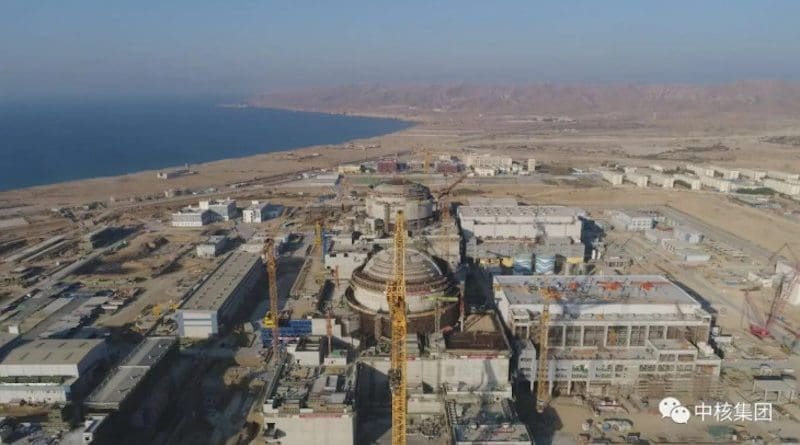Pakistan: Role Of Nuclear Power In Economic And Sustainable Development – OpEd
By Sher Bano*
On March 18th, 2021 ‘Pakistan’s Atomic Energy Commission’ (PAEC) announced that the 1,100 MW reactor of (KANUPP-2), the second unit of the ‘Karachi Nuclear Power Plant’ was connected to the national grid. This reactor is ACP-1000 or Hualong One and was supplied on a turnkey basis by ‘CNNC’ (China National Nuclear Corporation). KANUPP-2 would provide Pakistan with a more reliable and cost-effective source of electricity. This in turn would prove to be beneficial for the economic growth of the country. In order to meet its ever-increasing energy requirements, Pakistan has been significantly increasing the role of nuclear power that is rather an affordable alternative to fossil fuels. Hence this shift towards more reliable, modern, and affordable energy sources would lead Pakistan towards a more sustainable and equitable future.
To achieve the ‘SDGs’ (United Nations Sustainable Development Goals), Pakistan had been using nuclear technology for the country’s socio-economic development. There are diverse fields such as health, hydrology, electricity generation, environment, basic sciences, and agriculture in which nuclear technology is being used. The civil nuclear program of Pakistan is serving as an engine for the achievement of sustainable development goals that is to improve the energy security of the country by further utilizing the nuclear energy potential and becoming less dependent on fossil fuels. The operationalization of KANUPP-2 has further accentuated the aspirations of Pakistan to use nuclear energy for enhancing the power generation capacity of Pakistan. The KANUPP-2 workable life is expected to be 60 years that can be further extended to 80 years and is Pakistan’s first nuclear power plant with 1,100 MW of electricity generation capacity. The nuclear power plants are more reliable with a high capacity availability factor, are environment friendly and due to less fuel cost, the electricity price also remains sustainable.
Pakistan had faced an energy crisis during the previous decade primarily because of the existence of a huge gap in the supply and demand of electricity. According to the 2011-2012 report of the Economic Survey of Pakistan, the country was losing around USD 4.8 billion of Gross Domestic Production (GDP) annually for almost five years due to the energy crisis. According to few scholars, the reason behind energy shortage also lies within the energy mix of Pakistan, which relies excessively on thermal sources (natural gas, oil, and coal) causing high prices of electricity. Today at the end of the decade energy crisis in Pakistan is mitigated by planting several new energy generation plants (some of them were part of CPEC) and according to the most recent estimates of April 2020, the energy generation capacity in Pakistan is 35,972 megawatts as compared to 33,452 megawatts of April 2019. In one year Pakistan’s electricity generation capacity saw a growth rate of 7.5 %. At present energy demand in Pakistan is 25,000 megawatts; however, transmission and distribution capacity is only 22,000 megawatts, which explains interruptions in power supply in the country. At the moment through nuclear power, Pakistan is generating 8% electricity in total energy mix with five operational nuclear power plants and now KANUPP-2 would also be included.
The function of nuclear power generation falls under the domain of the Pakistan Atomic Energy Commission, along with the promotion of peaceful use of nuclear technology in the field of agriculture, medicine, and industrial projects. Pakistan aims to produce 8,800 MW of electricity from nuclear power by the year 2030 and after advice from PNRA and IAEA six new sites have been selected for this purpose. Usage of nuclear energy for peaceful purposes has always been the main focus of Pakistan, considering the growing energy needs of the country under CPEC nuclear energy would provide Pakistan with a clean and reliable energy source. Unlike thermal sources of electricity generation, nuclear energy protects air quality by producing a massive amount of carbon-free electricity.
Pakistan’s adherence to international practices of nuclear safety and security is evident from the very fact that for the past 48 years, Pakistan is producing electricity through nuclear power reactors and not a single major accident has occurred so far. IAEA has declared that the KANUPP-2 reactor ACP-1000 meets the safety standards of the ‘Generic Reactor Safety Review’ (GRSR). The review of ACP-1000 by the IAEA shows that the reactor has active and passive technology and that it fulfills the safety standards and requirements. Moreover, since March 2017 this reactor has been under IAEA safeguards. Such strong credentials are no doubt an acknowledgment of Pakistan’s efforts for peaceful uses of nuclear technology. At the same time, it would help Pakistan to meet the energy demand through a more peaceful, secure, and safe use of nuclear energy.
Hence in order to attain a sustainable future, Pakistan is increasing its reliance on more clean energy alternatives. Pakistan is on its way to building more nuclear power plants to further increase the role of nuclear power in overcoming future energy needs. Pakistan would also need international cooperation to meet its goal to have self-sufficiency in nuclear power and to further develop its nuclear power industry.
The writer is working as a Research Affiliate at the Strategic Vision Institute (SVI), a non-partisan think-tank based out of Islamabad, Pakistan

